Gem-TV in China: Overview and a Shanghai Case Study
March 6, 2015
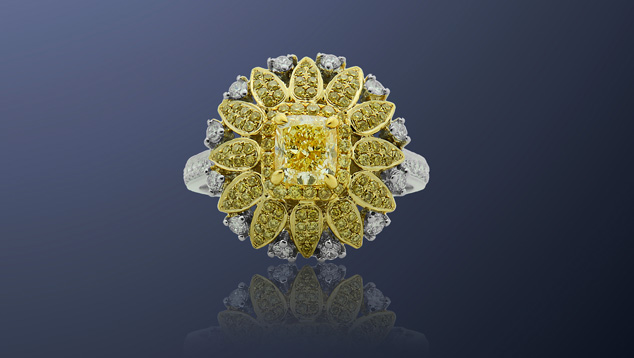
Introduction and Brief History
In the United States, the Home Shopping Network (HSN) launched its first national television shopping program on July 1, 1985. At the time, television in China was still considered a luxury product, affordable only for families with more financial power. A black and white TV could easily cost 400 RMB—about US$65, or a one-year salary for the average factory worker at the time. However, by the time color TV entered the Chinese market in the late 1980s and early 1990s, it was more widely affordable. The Chinese soon adopted the U.S. concept of TV shopping.China’s first TV shopping program was launched in 1992 by Guangdong Pearl River TV and Guangdong TV. The stations themselves collected the products and also created their own promotional videos. This first try was very successful. Then, Beijing’s first TV shopping company was established in 1995. It was initiated by Beijing TV (BTV) but was run independently. The company played the role of middleman between suppliers and end consumers. Within two years, its sales had reached 200 million RMB (about US$32 million).
Distribution of TV Shopping Networks in China
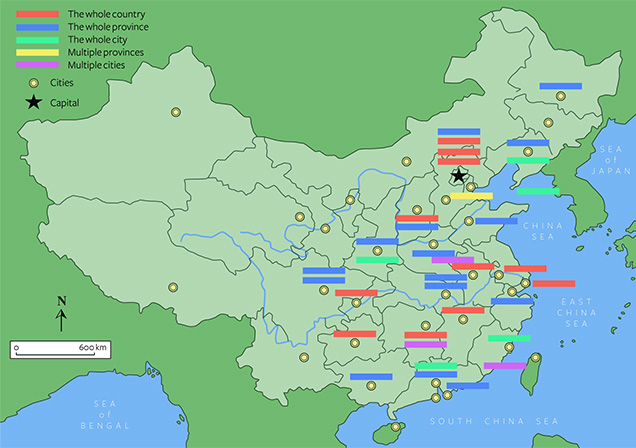
TV shopping network coverage has been increasing in China since the 1990s. Eastern China is covered by multiple layers of networks, while western China is still open. Map adapted from Zeng, 2012 (http://meijiezazhi.com/zt/yw/2013-02-25/11897.html).
In 2003, Shanghai Media Group Ltd. (SMG) signed a joint venture agreement with the CJ Home Shopping Co. of Korea. Investment by both parties formed a new company called SMG-CJ Home Shopping Co., Ltd. The new company sells its products through its TV network, company website, and a catalog. All three outlets share suppliers, management, and a ground transportation system. At the beginning, SMG-CJ covered only the Shanghai area. It now serves the entire country, with subgroups in various cities.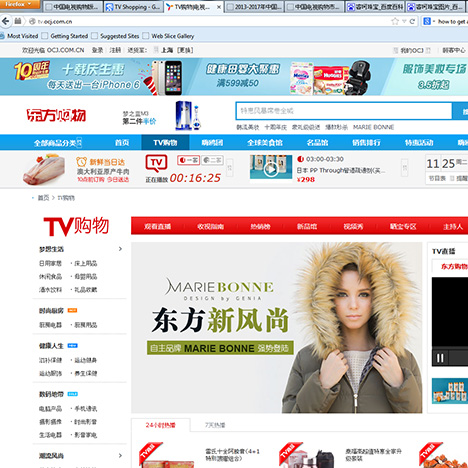
SMG-CJ is one of the most successful TV shopping networks in China. It has expanded
beyond serving only the Shanghai area and now serves all of China. Consumers can
place orders anytime on the company website.
When the live home-shopping program produced by SMG-CJ began on April 1, 2004, it aired every night from 8:00 pm to 1:00 am and was watched by over 3.5 million families. In November 2004, the company launched its website (http://tv.ocj.com.cn/) and started taking orders online. The company’s product catalog debuted in January 2005 and was mailed to more than 250,000 families.beyond serving only the Shanghai area and now serves all of China. Consumers can
place orders anytime on the company website.
Today, the company’s Shanghai home-shopping channel is live 24 hours a day, 7 days a week. Since the end of 2008, SMG-CJ has been a leader in the TV marketing of gold jewelry, diamonds, diamond jewelry, automobiles, and real estate.
In 2013, a team from GIA visited Shanghai and interviewed Mr. Shen Cheng, founder and CEO of Rico Gems, a gem and jewelry supplier for the SMG-CJ home-shopping channel. Shen generously shared with us his experience with—and insight into—Gem-TV in China.
Rico’s Shanghai Experience
After operating in the U.S. for around 20 years, Shen brought his brand back to mainland China in 2012. He did this at the suggestion of many of his friends in China and also because he recognized the unlimited potential of the Chinese gem and jewelry industry. Rico Gems specializes in high-end diamond and colored stone jewelry, serving customers with a wide range of products. The company has its own jewelry designers and manufacturer. Along with its successful collaboration with the SMG-GJ home-shopping network, it operates a store in Shanghai.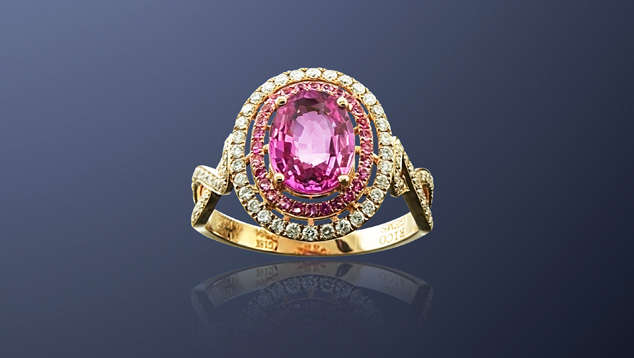
In addition to diamonds, Rico Gems also offers rare colored stones and is dedicated to promoting colored stone designs as wedding jewelry in China. This ring is a design from the “Forever Love” series of pink sapphire jewelry. Courtesy Rico Gems.
According to Shen, his TV shoppers are mainly affluent women, 30 to 50 years old. Most are middle class, but some are ultra-wealthy and can spend millions of dollars on rare pink diamonds without too much hesitation.Middle-class consumers consider many factors before finalizing a purchase. Many regard a diamond purchase as an investment, in hopes that the price will keep going up. Some consumers buy wedding rings for their children who are not planning to get married for several years, considering it a way to save money. Impulse purchases are a foreign concept to middle-class consumers in China.
Gem-TV Consumers
Shen targets a specific group of consumers by selling only diamonds over one carat in size through the TV-shopping network. The presenters spend about half an hour describing and promoting an item, and consumers have about the same amount of time to make a purchasing decision. Only a limited quantity of goods is offered at each show. A record for SMG-CJ was the sale of three two-carat fancy yellow diamonds (about US$40,000 each) within seconds of each other. Rico sells the faceted diamonds and usually provides the mountings for free. Sometimes the customer also receives a ruby or emerald as a free gift. It’s a practice that works very well with Shanghai consumers, Shen says, and contributes to a customer satisfaction rate of 100 percent.
Selling on Gem-TV
Shanghai is a very special city, one of the earliest open ports in China. People in Shanghai have grown accustomed to accepting new ideas from the rest of the world. The concept of TV shopping was borrowed from the Western world, and Shanghai consumers have embraced it as part of their everyday lives. Jewelry consumers have high confidence in TV shopping and the purchase of expensive products. Compared to Shanghai, jewelry consumers in other cities usually spend much less on each purchase.
Gem-TV Advantages for China’s Consumers
Unlike the Western world, Chinese television is under strong central-government control, and no private stations exist. China’s consumers see this as an advantage that makes TV purchases more trustworthy than purchases through other outlets. They feel that government control allows them to resolve any problems they might have—if they buy from a store, there’s no guarantee that the store’s location won’t change without notice, leaving them without recourse.Another advantage Gem-TV offers the Chinese consumer is price control. Rapid economic growth in China has raised land and property values, especially in cities like Beijing, Shanghai, and Guangzhou. Skyrocketing rents have forced store owners to increase their retail prices to ensure profits. Gem-TV’s suppliers are able to keep their rent costs low, making it easier to price their jewelry at a level that more consumers can afford. Also, consumers can easily compare prices before purchasing. In one of Rico’s TV shows, the price offered for a one-carat fancy yellow diamond was only about one-third of its market price.
Building Consumers’ Trust
Very strict control of suppliers and products helps Gem-TV gain consumer trust. For example, under rules set by SMG-CJ, the diamonds that Rico offers on TV have to carry two grading reports, one issued by GIA and the other by the National Gem and Jewelry Testing Center (NGTC) of China. If the grades on the two reports don’t match, the diamonds can’t be offered on TV. This might be a challenge for the suppliers, but it gives consumers more confidence in a purchase, especially with a more expensive stone.
Gem-TV Pricing
Last but not least, consumers usually get more information from a TV presentation than they do in a retail store. Shen says that SMG-CJ live shows are about thirty minutes long, and the time is used to describe and promote a featured item in detail. The description is very specific, and the presenter gives the item a more organized and comprehensive introduction. It also ensures that all consumers get the same information. Consumer feedback often indicates that they learn more from the TV shows than they do in retail stores.
The Market’s Future Potential
Sales through TV home-shopping networks account for about eight percent of total sales in the U.S., about 12 percent in Korea, and only about 0.3 percent in China. Even with a steady net increase of about 12 billion RMB (about US$2 billion) over the past five years, China’s TV-shopping sales percentage is still extremely low compared to other large economies. There is plenty of room to grow for this specific retail channel.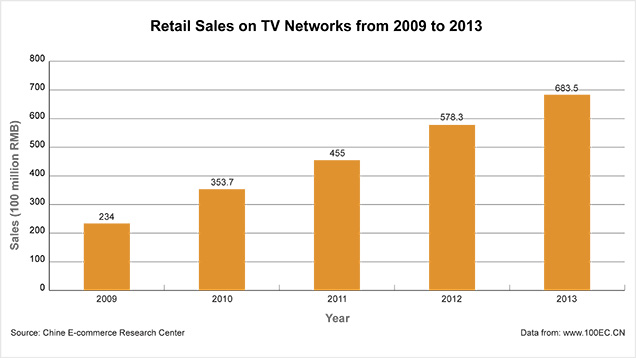
Sales from TV network shopping have continued to increase over the past five years. They reached about 70 billion RMB (about US$12 billion) in 2013.
China’s TV shopping channels are permitted to operate their own websites, giving consumers easy access to product information and more flexibility when placing orders. Some channels increase consumer access to their products by operating their own retail stores. Social networks are also very important sales channels in China. Many people who sell through social networks convert friends to consumers and vice versa.In the future, business owners will benefit more from combining multiple sales channels than from relying on a single one. In 2014, the Shanghai TV-shopping network decided to focus on developing its own mobile shopping application to go along with traditional sales channels. Mobile shopping is gaining tremendous momentum due to the younger generation’s increasing attachment to mobile devices rather than TV or retail stores. More and more jewelry brands recognize this change and consider mobile sales a new growth point.
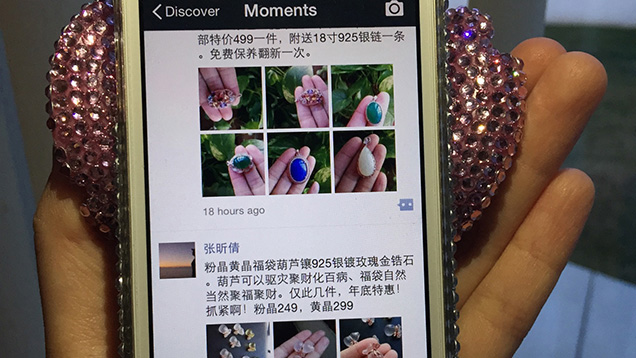
As China’s most popular social media network, Wechat has over 600 million users globally. Many brands and individual sellers promote and sell their products through this medium. Photo by Tao Hsu
In 2014, surveys showed that local consumers preferred buying jewelry and collectibles from TV networks, accounting for as much as 30 to 40 percent of total retail sales. As long as the TV shopping networks can maintain consumer confidence, sales will continue to increase. Shen notes that current Chinese consumers spend heavily on traditional collectibles and household goods. Many have not yet realized the investment potential of gemstones. With more education and promotion, more investment will be directed to the gem and jewelry market.Today, the major TV-shopping networks are all clustered in more-developed cities. As urbanization continues, people who live in lower-tier cities will become potential home shoppers. As the markets in first-tier cities become saturated, lower-tier cities offer the most growth potential.
About the Authors
Dr. Tao Hsu is technical editor of Gems & Gemology. Andrew Lucas is manager of field gemology for Content Strategy at GIA in Carlsbad.
DISCLAIMER
GIA staff often visit mines, manufacturers, retailers and others in the gem and jewelry industry for research purposes and to gain insight into the marketplace. GIA appreciates the access and information provided during these visits. These visits and any resulting articles or publications should not be taken or used as an endorsement.
Acknowledgments
The authors gratefully acknowledge the generous sharing of insights and experience from Mr. Shen Cheng, CEO of Rico Gems. We would also like to thank Mr. Xiaobo Lang for being our interpreter in Shanghai.



